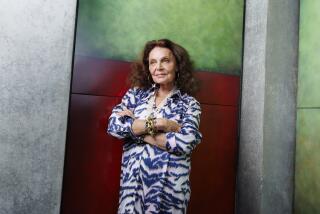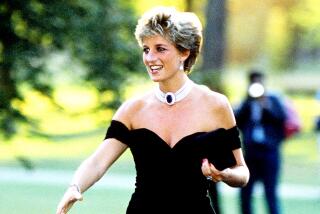The fashion legacy of Princess Diana is the subject of an exhibit in London
Reporting from London — Princess Diana’s life in the public eye and evolution as a woman can be traced through her clothes. That’s the theme of “Diana: Her Fashion Story,” a new exhibition at Kensington Palace in London curated and presented by Historic Royal Palaces.
The exhibit, which will run through 2018, coincides with the 20th anniversary of Princess Diana’s death and is intended to reveal her sartorial development via several rooms of outfits and gowns.
“The exhibition tells a story from beginning to end,” says Deirdre Murphy, senior curator at Historic Royal Palaces. “That’s all well and good when you’re looking at a list and looking at these garments individually. But once you see them all in the space you realize what a huge transformation Diana went through from her very early days as Lady Diana Spencer to 1997 when we see those glamorous and slick photographs taken by Mario Testino.”
The displays, at the back of Kensington Palace near where Diana once lived, are presented thematically, beginning with a room of formal dresses that include a blue silk chiffon evening gown designed by Catherine Walker, which Diana wore to the Cannes Film Festival in 1987. The gowns establish Diana has a fashion-forward icon, revealing an early love of pastel colors and feminine lines.
“Diana was a big patron of British fashion,” says Poppy Cooper, exhibition producer, noting that the princess often played with the idea of traditional royal dress. The favored designers, displayed here, include Walker, Bellville Sassoon, Emanuel and Victor Edelstein. “If she wore something it would have an immediate effect,” Cooper adds.
As the rooms unfold, Diana’s interest in pushing against tradition reveals itself. Her famous black and red gown, designed by Murray Arbeid and worn to the America’s Cup Ball at the Grosvenor House Hotel in 1986, showcases her ability to experiment. The dress, which echoes Spanish flamenco costumes, was paired with one black glove and one red glove. This caused what the exhibition text calls “a media furor.”
Diana’s relationship with the press – and by extension the public – is at the center of the displays. Each ensemble is paired with a photograph of Diana wearing it. She knew she would be photographed from all angles, so the dresses were designed with that in mind. “She understood that her image was very powerful,” Cooper notes. “She wanted to use that.” (And, in fact, according to the exhibition, magazine circulation went up by 40% every time a photograph of Diana appeared on a cover.)
That idea is especially apparent in Diana’s “working wardrobe,” which she wore during her charity efforts. These pieces, which include several Catherine Walker day suits, were intended to showcase her as a workhorse rather than a clothes horse and to suggest her role as a working mother. She often elected not to wear gloves, going against tradition to ensure she made direct contact with the people. “She chose very simple-looking items in hopes that people would focus on her work,” Cooper says.
The final room showcases several gowns sold in Diana’s 1997 Christie’s auction, which took place the year she passed away. These dresses are slicker and tighter than those in the first room, revealing her transformation over the course of a decade from demure royal wife to confident woman of the world. For each dress or item, there is often a memory attached, one that comes with the viewer when they arrive at Kensington Palace.
“She was someone who on such a public stage managed to give people the impression that they knew her,” Murphy says. “For most people, myself included, the most we ever saw of her was through imagery and interviews and formal portrait photographs. It’s interesting to see how people who were around at that time respond to these objects in person and on display here. That juxtaposition of the personal story of the viewer and the woman that became this fashion icon through the media is a fascinating dialogue.”
“Diana: Her Fashion Story” brings many dresses to public display for the first time ever. Seen all together in the same space, the exhibit ultimately acts as a reminder of the princess’ surviving legacy as a beloved public figure and a fashion icon. “Her appeal is enduring now, 20 years later,” Murphy says. “Somehow millions of people still manage to see a piece of themselves in her.”
Tickets for the exhibition, which includes admission to Kensington Palace, are 19 pounds (about $23) for adults and free for children.
More to Read
The biggest entertainment stories
Get our big stories about Hollywood, film, television, music, arts, culture and more right in your inbox as soon as they publish.
You may occasionally receive promotional content from the Los Angeles Times.










